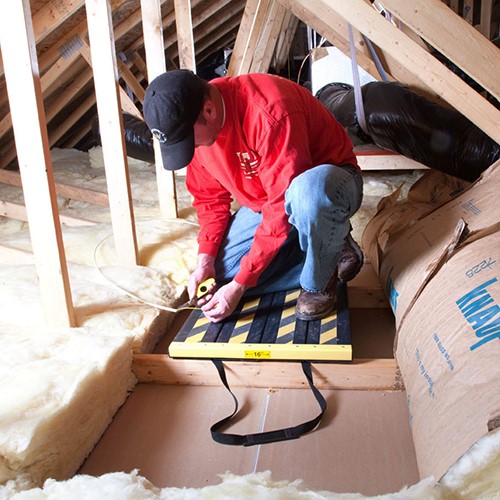
The Joistmate™ attic safety platform in use. Weighs only 10 lbs, and comes with carrying strap.
Work in attics can be hot (or cold), difficult and dangerous if you’re not at the top of your game. The attic in IPM Experience House is no different. Here are a few safety tips for pest control work in attics:
- Schedule attic work for the morning in summertime if possible. Summer afternoon temperatures in Texas attics can range from 120 to 180 degrees F– dangerously high.
- Most pest control inspections in attics will be relatively short, but if you are going to spend any significant time in an attic, make sure to hydrate.
- Wear proper clothing. Long-sleeved shirt tucked into pants, gloves, safety glasses and bump hat are essential protective gear. If you don’t have a bump hat, any hat is better than none.
- Wear a respirator. A disposable N95 respirator is the minimal protection you need from any airborne fibers in attics. If you suspect rodents are present, especially deer mice in rural homes, more sophisticated protection may be needed.
- Carry any loose tools you need in a tool bag that you can drag with you. Always set your tools aside in the tool bag to avoid losing them among insulation.
- If you must travel from stable flooring onto joist beams, maintain three points of contact at all times. Move only one foot or hand at a time, keeping your other feet and hands on a secure joist or rafter. The Joistmate™ platform you see here, can provide a stable platform for working on joists.
- Never step blindly into insulation assuming a joist or floor decking will be there. If you cannot see the decking, beams or joists, DON’T STEP THERE. Don’t assume that all joists are on 16 inch centers, 24 inches is common in newer homes.
- Be wary of beams or joists that might be damaged by termites or rot. They may not hold your weight.
- Be wary of bee hives or wasp nests, or other pests like rats, bats or raccoons. Another good reason to have at least three good hand-holds or secure footing at all times. Always think about your escape route in case you encounter an animal.
- Bring a corded work light or backup flashlight to the attic in case you drop your primary flashlight, or in case of battery failure.
- Make sure any ladders you use are firmly set up and rated for your weight. Place plastic under the attic ladder, or be prepared to vacuum any insulation or debris that falls from the attic into the house.